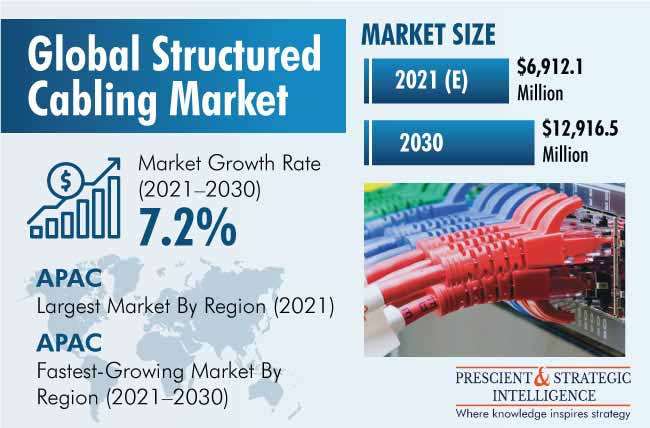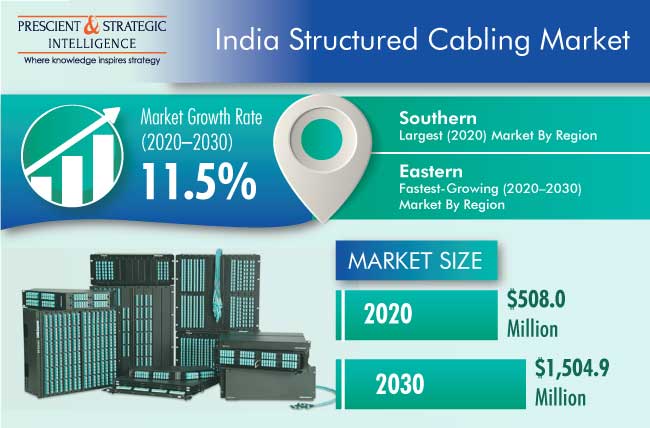Growing Internet Penetration Supporting Structured Cabling Market Surge in Asia-Pacific
The global structured cabling market revenue stood at $6,912.1 million in 2021, and it is predicted to rise to $12,916.5 million by 2030. According to the estimates of the market research organization, P&S Intelligence, the market will exhibit a CAGR of 7.2% from 2021 to 2030 (forecast period). The major factors fueling the expansion of the market are the growing requirement for high bandwidths and demand for effective cabling management. Additionally, the advent of the internet of things (IoT) is also supporting the growth of the market across the globe.
The surging penetration of the internet has caused a sharp rise in the need for high bandwidths, as high bandwidths enable the smooth operation of various business processes. Since cabling can provide high bandwidths, the growing demand for improved bandwidths is driving the expansion of the structured cabling market. Enterprises are rapidly modifying their information technology (IT) infrastructure, on account of the mushrooming use of bandwidth-intensive applications, such as IP-based videoconferencing, digital audio and video, and voice over IP (VoIP).
Cabling is being increasingly used by companies operating in the government, commercial, industrial, and telecommunication sectors for improving their IT infrastructure. Structured cabling assists in making cabling management simple, as it can be easily managed and laid down without requiring a large number of skilled staff members. Thus, the soaring requirement for hassle-free IT infrastructure is propelling the progress of the market, as it reduces the time and costs for government agencies, industries, and data centers.
It provides a more standardized and organized approach in comparison to patch cords. Depending on product, the structured cabling market is divided into fiber cables, copper cables, fiber components, and copper components. Out of these, the fiber cables category is predicted to demonstrate the highest growth rate in the market in the forthcoming years. This is credited to the growing requirement for high bandwidths, high network security, reliable networking, and low signal attenuation.
The market is also categorized into commercial, telecommunication, industrial, and government, on the basis of end use. Amongst these, the telecommunication category is predicted to contribute the highest revenue to the market in the coming years. This is credited to the growing penetration of the internet and mushrooming requirement for high-speed internet connectivity, especially in emerging economies across the world. Geographically, Asia-Pacific (APAC) will hold the largest share in the structured cabling market in the forthcoming years.
This is ascribed to the growing need for cloud computing, which is subsequently pushing up the demand for structured cabling at data centers. Additionally, the progress of the Indian structured cabling industry is also supporting the growth of the regional market. This is attributed to the ballooning requirement for copper structured cabling, owing to the rising demand for high data transmission rates and improved bandwidth in the country. Additionally, the rapid digitization of business operations in various regional countries is also supporting the expansion of the market in the region.
Hence, it can be safely said that the demand for structured cabling will surge sharply in the coming years, primarily because of the increasing internet penetration and growing need for high bandwidths.
Read More: https://www.psmarketresearch.com/market-analysis/structured-cabling-market
The global structured cabling market revenue stood at $6,912.1 million in 2021, and it is predicted to rise to $12,916.5 million by 2030. According to the estimates of the market research organization, P&S Intelligence, the market will exhibit a CAGR of 7.2% from 2021 to 2030 (forecast period). The major factors fueling the expansion of the market are the growing requirement for high bandwidths and demand for effective cabling management. Additionally, the advent of the internet of things (IoT) is also supporting the growth of the market across the globe.
The surging penetration of the internet has caused a sharp rise in the need for high bandwidths, as high bandwidths enable the smooth operation of various business processes. Since cabling can provide high bandwidths, the growing demand for improved bandwidths is driving the expansion of the structured cabling market. Enterprises are rapidly modifying their information technology (IT) infrastructure, on account of the mushrooming use of bandwidth-intensive applications, such as IP-based videoconferencing, digital audio and video, and voice over IP (VoIP).
Cabling is being increasingly used by companies operating in the government, commercial, industrial, and telecommunication sectors for improving their IT infrastructure. Structured cabling assists in making cabling management simple, as it can be easily managed and laid down without requiring a large number of skilled staff members. Thus, the soaring requirement for hassle-free IT infrastructure is propelling the progress of the market, as it reduces the time and costs for government agencies, industries, and data centers.
It provides a more standardized and organized approach in comparison to patch cords. Depending on product, the structured cabling market is divided into fiber cables, copper cables, fiber components, and copper components. Out of these, the fiber cables category is predicted to demonstrate the highest growth rate in the market in the forthcoming years. This is credited to the growing requirement for high bandwidths, high network security, reliable networking, and low signal attenuation.
The market is also categorized into commercial, telecommunication, industrial, and government, on the basis of end use. Amongst these, the telecommunication category is predicted to contribute the highest revenue to the market in the coming years. This is credited to the growing penetration of the internet and mushrooming requirement for high-speed internet connectivity, especially in emerging economies across the world. Geographically, Asia-Pacific (APAC) will hold the largest share in the structured cabling market in the forthcoming years.
This is ascribed to the growing need for cloud computing, which is subsequently pushing up the demand for structured cabling at data centers. Additionally, the progress of the Indian structured cabling industry is also supporting the growth of the regional market. This is attributed to the ballooning requirement for copper structured cabling, owing to the rising demand for high data transmission rates and improved bandwidth in the country. Additionally, the rapid digitization of business operations in various regional countries is also supporting the expansion of the market in the region.
Hence, it can be safely said that the demand for structured cabling will surge sharply in the coming years, primarily because of the increasing internet penetration and growing need for high bandwidths.
Read More: https://www.psmarketresearch.com/market-analysis/structured-cabling-market
Growing Internet Penetration Supporting Structured Cabling Market Surge in Asia-Pacific
The global structured cabling market revenue stood at $6,912.1 million in 2021, and it is predicted to rise to $12,916.5 million by 2030. According to the estimates of the market research organization, P&S Intelligence, the market will exhibit a CAGR of 7.2% from 2021 to 2030 (forecast period). The major factors fueling the expansion of the market are the growing requirement for high bandwidths and demand for effective cabling management. Additionally, the advent of the internet of things (IoT) is also supporting the growth of the market across the globe.
The surging penetration of the internet has caused a sharp rise in the need for high bandwidths, as high bandwidths enable the smooth operation of various business processes. Since cabling can provide high bandwidths, the growing demand for improved bandwidths is driving the expansion of the structured cabling market. Enterprises are rapidly modifying their information technology (IT) infrastructure, on account of the mushrooming use of bandwidth-intensive applications, such as IP-based videoconferencing, digital audio and video, and voice over IP (VoIP).
Cabling is being increasingly used by companies operating in the government, commercial, industrial, and telecommunication sectors for improving their IT infrastructure. Structured cabling assists in making cabling management simple, as it can be easily managed and laid down without requiring a large number of skilled staff members. Thus, the soaring requirement for hassle-free IT infrastructure is propelling the progress of the market, as it reduces the time and costs for government agencies, industries, and data centers.
It provides a more standardized and organized approach in comparison to patch cords. Depending on product, the structured cabling market is divided into fiber cables, copper cables, fiber components, and copper components. Out of these, the fiber cables category is predicted to demonstrate the highest growth rate in the market in the forthcoming years. This is credited to the growing requirement for high bandwidths, high network security, reliable networking, and low signal attenuation.
The market is also categorized into commercial, telecommunication, industrial, and government, on the basis of end use. Amongst these, the telecommunication category is predicted to contribute the highest revenue to the market in the coming years. This is credited to the growing penetration of the internet and mushrooming requirement for high-speed internet connectivity, especially in emerging economies across the world. Geographically, Asia-Pacific (APAC) will hold the largest share in the structured cabling market in the forthcoming years.
This is ascribed to the growing need for cloud computing, which is subsequently pushing up the demand for structured cabling at data centers. Additionally, the progress of the Indian structured cabling industry is also supporting the growth of the regional market. This is attributed to the ballooning requirement for copper structured cabling, owing to the rising demand for high data transmission rates and improved bandwidth in the country. Additionally, the rapid digitization of business operations in various regional countries is also supporting the expansion of the market in the region.
Hence, it can be safely said that the demand for structured cabling will surge sharply in the coming years, primarily because of the increasing internet penetration and growing need for high bandwidths.
Read More: https://www.psmarketresearch.com/market-analysis/structured-cabling-market
0 Comments
0 Shares
0 Reviews





